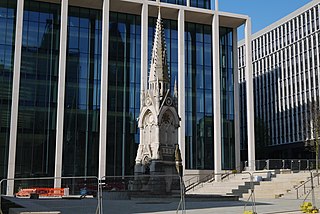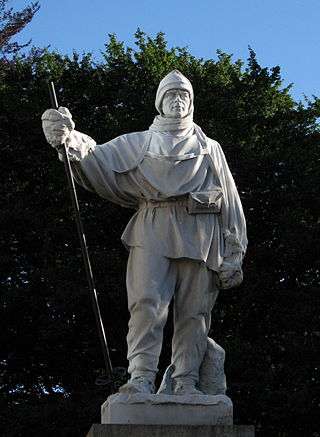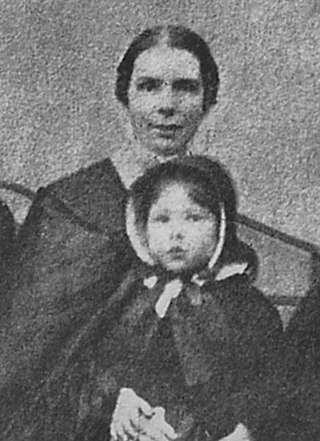
Chamberlain Square or Chamberlain Place is a public square in central Birmingham, England, named after statesman and notable mayor of Birmingham, Joseph Chamberlain. The Victorian square was drastically remodelled in the 1970s, with most of the Victorian buildings demolished and the construction of the Brutalist Central Library. Re-landscaping occurred most recently when the square was closed to the public for five years until March 2021 for remodelling as part of the Paradise scheme.

Joseph Sturge was an English Quaker, abolitionist and activist. He founded the British and Foreign Anti-Slavery Society. He worked throughout his life in Radical political actions supporting pacifism, working-class rights, and the universal emancipation of slaves. In the late 1830s, he published two books about the apprenticeship system in Jamaica, which helped persuade the British Parliament to adopt an earlier full emancipation date. In Jamaica, Sturge also helped found Free Villages with the Baptists, to provide living quarters for freed slaves; one was named Sturge Town in his memory.

Five Ways is an area of Central Birmingham, England. It takes its name from a major road junction, now a busy roundabout to the south-west of the city centre which lies at the outward end of Broad Street, where the Birmingham Middle ring road crosses the start of the A456.

Birmingham Civic Society is a voluntary body in Birmingham, England, and is registered with the Civic Trust.
Free Villages is the term used for Caribbean settlements, particularly in Jamaica, founded in the 1830s and 1840s with land for freedmen independent of the control of plantation owners and other major estates. The concept was initiated by English Baptist missionaries in Jamaica, who raised funds in Great Britain to buy land to be granted to freedmen after emancipation. The planters had vowed not to sell any land to freedmen after slavery was finally abolished in the Empire in 1838; they wanted to retain freedmen as agricultural workers. The Free Villages were often founded around a Baptist church, and missionaries worked to found schools as well in these settlements.

William Robert Colton was a British sculptor. After completing his studies in London and Paris, Colton established himself with solid, career-long business relationships, secured admission to exhibitions at the Royal Academy and the Salon in Paris. His works included commissions for busts, statues and war memorials. His clientele included royalty in England and India.

The Statue of Robert Falcon Scott commemorates Antarctic explorer Robert Falcon Scott. It is located at the intersection of Oxford Terrace and Worcester Street in the Christchurch Central City, New Zealand. The statue, carved by Scott's widow Kathleen Scott, is registered as a Category II historic place. The statue toppled off its plinth in the February 2011 Christchurch earthquake and broke in two; it was temporarily on display in the Christchurch Earthquake Museum in City Mall. The Scott statue was reinstated in October 2017.

Edmund Sturge, was a Quaker businessman and campaigner for liberal causes.

A Memorial to Queen Victoria stands in Woodhouse Moor, Leeds, West Yorkshire, England.

The London Troops War Memorial, located in front of the Royal Exchange in the City of London, commemorates the men of London who fought in World War I and World War II.

The Morley War Memorial is a British national war memorial situated in Scatcherd Park, Morley, Leeds, England. Sculpted by Walter Henry Gilbert and cast by H. H. Martyn and Co., it was unveiled 21 May 1927 by Alderman Joseph Kirk and accepted by Mayor Alderman Thomas Marshall. The war memorial was added to the National Heritage List for England on 17 June 1986 as a Grade II listed structure.

The Royal Artillery Boer War Memorial is located on the south side of The Mall in Central London, close to the junction with Horse Guards Road at the northeast corner of St James's Park. Unveiled in 1910, it marks the deaths of the 1,083 soldiers of the Royal Artillery who died in the Second Boer War from 1899 to 1902 It has been a listed building since 1970.

A bronze statue of General Charles George Gordon by Hamo Thornycroft stands on a stone plinth in the Victoria Embankment Gardens in London. It has been Grade II listed since 1970. A similar statue stands at Gordon Reserve, near Parliament House in Melbourne, Australia, on its original tall plinth.

A bronze statue of Mahatma Gandhi by Fredda Brilliant was unveiled in 1968 at the centre of Tavistock Square in London, to mark the impending centenary of Gandhi's birth in 1869. Mahatma Gandhi had studied law at University College London nearby from 1888 to 1891, before being called to the bar at the Inner Temple.

Sophia Sturge (1849–1936) was a British Quaker suffragist, social reformer and peace campaigner who carried out activities in opposition to World War I.

The statue of Edward Colston is a bronze statue of Bristol-born merchant and trans-Atlantic slave trader, Edward Colston (1636–1721). It was created in 1895 by the Irish sculptor John Cassidy and was formerly erected on a plinth of Portland stone in a public park known as "The Centre", until it was toppled by anti-racism protestors in 2020.

Hannah Sturge born Hannah Dickinson was a British Quaker philanthropist. She and her husband Joseph Sturge were spoken about internationally as pre-eminent in both the abolition and peace movements
Sophia Sturge was a British slavery abolitionist based in Birmingham. She founded the "Birmingham Ladies Society for the Relief of Negro Slaves" and devoted much of her life to supporting her brother who was one of the UK's leading abolitionists.

A bronze statue of Robert Stephenson by Carlo Marochetti usually stands on a red granite plinth in the forecourt of Euston railway station in London, England. Erected in 1871, it is one of few surviving elements of the original station after it was redeveloped in the 1960s, and it became a Grade II listed building in 1974. It was temporarily removed in 2020 to allow the station to be remodelled to accommodate the new High Speed 2 (HS2) railway line.
The Statue of Queen Victoria stands on the sea front at the bottom of Grand Avenue in Hove on the south coast of England. The statue is one of 14 by Thomas Brock and was unveiled in February 1901, the month after Queen Victoria's death. It is a grade II listed building.






















